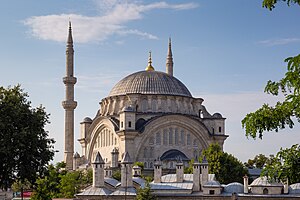Masjid Nuruosmani
| Masjid Nuruosmani Nuruosmaniye Camii | |
|---|---|
 | |
| Agama | |
| Afiliasi | Islam – Sunni |
| Provinsi | Istanbul |
| Lokasi | |
| Lokasi | Fatih |
| Negara | |
| Arsitektur | |
| Arsitek | Mustafa Ağa dan Simon Kalfa |
| Tipe | Masjid |
| Gaya arsitektur | Turki dengan sedikit sentuhan arsitektur Utsmaniyah |
| Didirikan | 1775 |
| Spesifikasi | |
| Kubah | 1 |
| Menara | 2 |
Masjid Nuruosmani (bahasa Turki: Nuruosmaniye Camii) adalah sebuah masjid peninggalan Kesultanan Utsmaniyah pada abad ke-18 yang berada di kawasan Çemberlitaş, distrik Fatih, Provinsi Istanbul, Turki. Masjid ini sempat terdaftar di Situs Warisan Dunia UNESCO pada tahun 2016.[1] Kubah masjid ini memiliki arsitektur yang sangat berbeda, dan terbesar keempat di kota Istanbul, selain kubah Masjid Hagia Sophia, Masjid Suleiman, dan Masjid Fatih.
Masjid ini merupakan bagian dari kompleks keagamaan yang lebih besar, yang bertindak sebagai pusat budaya, agama, dan pendidikan bagi lingkungan sekitar. Masjid ini juga merupakan masjid peninggalan kesultanan pertama di Istanbul–Kesultanan Utsmaniyah–yang mengintegrasikan elemen Barok dan neoklasik dalam konstruksinya,[2] serta dibangun dengan gaya Ottoman Baroque.
Muqarnas masjid ini dan halamannya yang melengkung menunjukkan pengaruh Barok. Masjid tersebut terletak di bukit kedua Istanbul, di situs bekas masjid Fatma Huton; yang kemudian masjid itu terbakar karena kebakaran. Di Konstantinopel, kawasan masjid ini berdekatan dengan Forum Konstantin, tempat Tiang Konstantin (bahasa Turki: Çemberlitaş Sütunu) berada. Di sekeliling masjid ini terdapat Grand Bazaar Istanbul (bahasa Turki: Kapalıçarşı). Setelah pembangunan Masjid Sultan Ahmed selesai, masjid Nurosmaniye menjadi masjid kekaisaran pertama yang dibangun dalam jangka waktu 100 tahun.[3]
Referensi
[sunting | sunting sumber]- ^ "Nuruosmaniye Complex". UNESCO World Heritage Centre. UNESCO. Diakses tanggal 8 June 2018.
- ^ Suman, Selva (2011). "Questioning an "Icon of Change": The Nuruosmaniye Complex and the Writing of Ottoman Architectural History" (PDF). METU Journal of the Faculty of Architecture: 145–166. doi:10.4305/METU.JFA.2011.2.7
 .
.
- ^ Rüstem, Ünver (2019). Ottoman Baroque: The Architectural Refashioning of Eighteenth-Century Istanbul. Princeton: Princeton University Press. ISBN 978-0-691-18187-5.
Pranala luar
[sunting | sunting sumber]Text is available under the CC BY-SA 4.0 license; additional terms may apply.
Images, videos and audio are available under their respective licenses.


